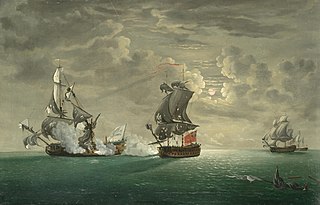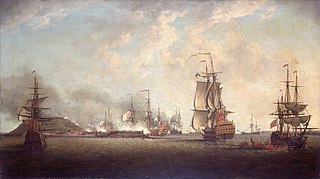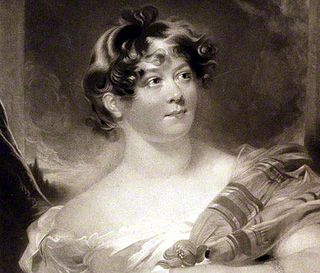
HMS Bellona was a 74-gun Bellona-class third-rate ship of the line of the Royal Navy. Designed by Sir Thomas Slade, she was a prototype for the iconic 74-gun ships of the latter part of the 18th century. "The design of the Bellona class was never repeated precisely, but Slade experimented slightly with the lines, and the Arrogant, Ramillies, Egmont, and Elizabeth classes were almost identical in size, layout, and structure, and had only slight variations in the shape of the underwater hull. The Culloden-class ship of the line was also similar, but slightly larger. Thus over forty ships were near-sisters of the Bellona." Bellona was built at Chatham, starting on 10 May 1758, launched on 19 February 1760, and commissioned three days later. She was the second ship of the Royal Navy to bear the name, and saw service in the Seven Years' War, American Revolutionary War and the Napoleonic Wars.
HMS Victorious was a 74-gun third rate ship of the line of the Royal Navy, launched at Blackwall Yard, London on 27 April 1785. She was the first ship of the Royal Navy to bear the name.

HMS Monmouth was a 66-gun third-rate ship of the line of the Royal Navy, and was likely named for James, Duke of Monmouth. She served from 1667 to 1767, winning ten battle honours over a century of active service. She was rebuilt a total of three times during her career—each time effectively becoming a completely new ship.

HMS Lichfield was a 50-gun fourth rate ship of the line of the Royal Navy, built at King's Yard in Harwich by John Barnard to the dimensions laid down in the 1741 proposals of the 1719 Establishment, and launched on 26 June 1746. She was wrecked on the Barbary Coast of North Africa on 28 November 1758.

HMS Audacious was a 74-gun third-rate ship of the line of the Royal Navy, launched on 23 July 1785 at Rotherhithe. She was the first ship to bear the name.

HMS Majestic was a 74-gun third-rate ship of the line launched on 11 December 1785 at Deptford.

HMS Valiant was a 70-gun third rate ship of the line of the Royal Navy, modelled on the captured French ship Invincible and launched on 1 August 1759 at Chatham Dockyard. Her construction, launch and fitting-out are the theme of the 'Wooden Walls' visitor experience at Chatham Historic Dockyard. She served under Augustus Keppel during the Seven Years' War, and was with him at the Capture of Havana, in 1763.

The Ardent-class ships of the line were a class of seven 64-gun third rates, designed for the Royal Navy by Sir Thomas Slade.
HMS Stately was a 64-gun third-rate ship of the line of the Royal Navy, launched on 27 December 1784 at Northam.

HMS Egmont was a 74-gun third rate ship of the line of the Royal Navy, launched on 29 August 1768 at Deptford. She was designed by Sir Thomas Slade, and was the only ship built to her draught.

HMS Resolution was a 74-gun third rate ship of the line of the Royal Navy, designed by Sir Thomas Slade and built by Adam Hayes at Deptford Dockyard and launched on 12 April 1770. The ship had a huge crew of 600 men. As one of the Royal Navy's largest ships she took part in seven major naval battles.
HMS Terrible was a 74-gun third rate ship of the line of the Royal Navy, launched on 28 March 1785 at Rotherhithe.

HMS Vigilant was a 64-gun third-rate ship of the line of the Royal Navy, launched on 6 October 1774 at Bucklers Hard.

HMS Oxford was a 54-gun fourth-rate ship of the line of the Royal Navy, built by Francis Baylie in Bristol and launched in June 1674. Her guns comprised twenty-two 24-pounders on the lower deck, with twenty-two large sakers (8-pounders) on the upper deck and ten smaller sakers (5-pounders) on the quarter deck.

HMS Neptune was a 90-gun second-rate ship of the line of the Royal Navy. She was built under the 1677 "Thirty Great Ships" Programme and launched in 1683 at Deptford Dockyard.
HMS Dorsetshire, the first Royal Navy ship to be named after the county of Dorset, was an 80-gun third rate ship of the line of the Royal Navy, launched at Southampton on 8 December 1694.
Six ships of the Royal Navy have borne the name HMS Nassau, after King William III who was of the House of Orange-Nassau, with the County of Nassau being a subsidiary holding of that family:

HMS Nassau was a 70-gun third rate ship of the line of the Royal Navy, built at Portsmouth Dockyard and launched on 9 January 1706.

HMS Dunkirk was a 60-gun fourth-rate ship of the line of the Royal Navy, built by Edward Allin at Woolwich Dockyard to the draught specified by the 1745 Establishment as amended in 1750, and launched on 22 July 1754.

Harriett Litchfield or Miss Sylvester Hay was a British actress.














